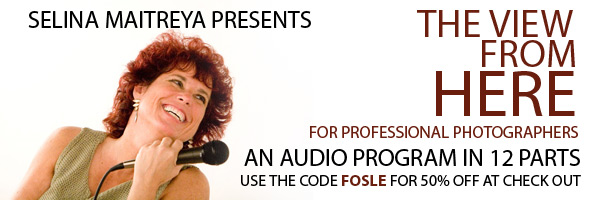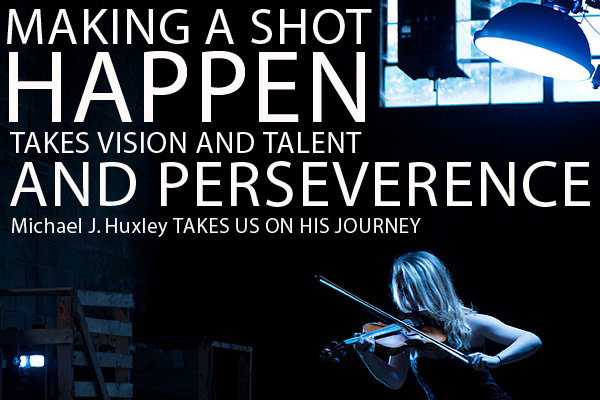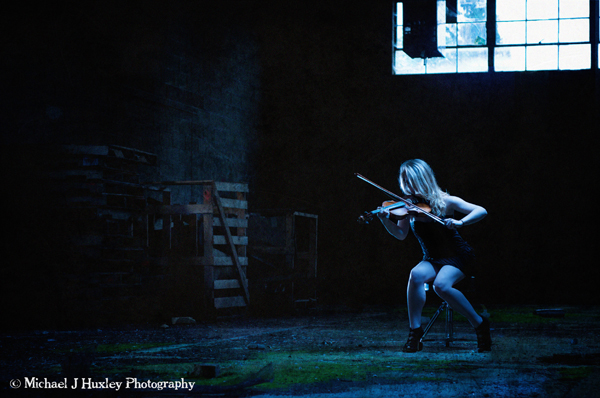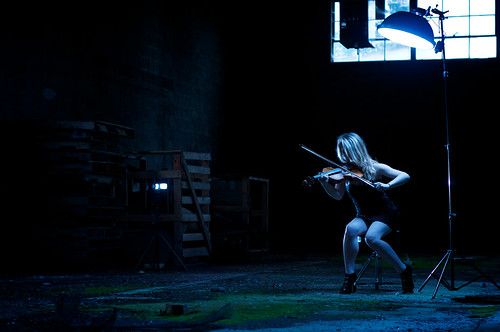Working the thought out from conception to realization. Pre-visualization and tenacity blend to help a photographer go from reacting to an image situation to creating an image situation. It is a very powerful technique.
I saw this photograph by photographer Michael J. Huxley on a Flickr page and the thumbnail just jumped out at me. Then I read the description of how he did it and why and sent him an email asking him to describe the process for you.
Michaels Photo:
I loved the fact that he pre-visualized the image, then did what he had to do to make it look like he saw it in his head. Trust me when I say that is a milestone for a photographer. The ability to start to see images BEFORE taking them is a great place to be – and it opens the door to so many possibilities as well as helping a photographer create ‘vision’.
Let’s let Michael tell it his way:
— —
“The violin image is actually just a test I did for an upcoming shoot involving a cello.
This image is really significant to me because it’s the first image I’ve taken that started out with a true vision. Before, I’ve always had a very general idea of what I wanted to do at a photo shoot. This image was crystal clear in my head from day 1.
The creative process in developing the image was actually a bit strange. The image coalesced from several random and seemingly unrelated elements. I was in touch with a fellow photograph who wanted to trade family portraits; she would photograph my family and I would shoot hers (her husband was leaving for military duty in October and she wanted images done before he left). I decided I wanted to shoot her family as if they were a Depression Era band: upright bass, maybe a big moonshine jug, etc. She loved the idea and mentioned that she played cello and could maybe use that.
Meanwhile, I had been searching for music to listen while editing, something without lyrics so I could concentrate. I remembered Apocalyptica, a group of 4 cellists who started out doing Metallica covers on cello but have since moved on to writing original music. I downloaded their new album “7th Symphony” and had been listening to it voraciously.
I’ve also recently found tremendous inspiration in the work of two photographers, the first being Brooke Shaden(possibly NSFW) – her work has so much emotion, and tells such an amazing story, I find myself coming back to view it constantly. The second photographer is Annie Bertram whose work is fantastically gothic and lush.
So all of this is just floating around my brain for days and weeks when, like a flash of light in my head, this image pops into my head – I can’t remember what I was doing, but it stopped me in my tracks. I’ve never had an image look so defined in my head before, I could see every detail.
So I put a call out on Facebook for locations, and was lucky enough to find the location that we shot at – gigantic abandoned warehouse about 20 minutes from my house. It was the first shot I took that day and it’s still my favorite.
The original image, straight out of the camera is up on my Flickr, here (and yeah, that’s a DIY Beauty Dish – it’s my absolute favorite, it’s the first modifier I grab when out on a shoot). The camera is set to Tungsten White Balance and both lights have additional blue gels on them to deepen the blue.
Michael’s original image before Photoshop:
I knew right away that I was going to need to use the technique you wrote about on LE about increasing the power of your flash in Photoshop. One of those brilliantly simple techniques that is so obvious once you know it – but a very handy one to have. Also in post I added some texture and noise to give it my own version of the “Brooke Shaden” treatment. I’m not usually one for doing that much post work, but it was part of the image I saw.
I think that’s integral to these techniques: see the finished image in your head before you ever even put the camera to your eye. It makes the image look deliberate instead of haphazard. I’ve had some comments about cropping out the window, and I did try that but was unhappy with the result. First, it gives a conceivable (though unlikely) source to the light that falls on her. Second, that really crowded the model – and that was an important part, for me, the sense of space around her.”
— —
Thanks Michael, we appreciate this wonderful explanation and insight into what it is like to truly ‘create’ an image. And thanks for remembering some of the techniques we talk about here on Lighting Essentials.
Photographer:
Michael J. Huxley
315-775-3887
Email
Website
Follow me on Twitter, and visit the Workshop Page.









Thanks so much Don! Quite an honor to see my image on your site.
That’s a beautiful photograph. I think that this thinking process comes naturally to some people and for others will require some training, there are so many possibilities today that only practice will make you know when is the time to apply this or that technique.
A long way to be there, but I am enjoying the sights on my way and I am not in a rush, so I will let it all grow slowly.
just a ordinary shot… nothing special about this shot anyway
Thanks for your insight. Appreciated so much.
Compelling image, Michael. I really enjoyed the read, too. I find that music and other arts and concepts dictate my images also, and it’s such a tough job to pull it together. That part of creating art does not come easy to me, it is inspiring to read how it worked for you.
Great shot, but as a musician I am a little bothered by the fact that she is holding the violin in the wrong hand. Aside from that, I love the lighting and the location. Great work! I am interested to see what the cello photos look like! I love it when photos you see in your head come through the lens. I have had a few instances like that and it is a great thrill as I am trying new ideas.
Good eye Will! Actually she is holding it in the correct hand – I’m a lefty and when I started learning, I got a lefty violin. It was rather awkward for her.